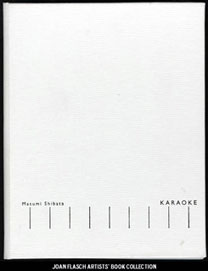 Karaoke By Masumi Shibata Rochester, New York: Preacher's Biscuits Books, 2005. 7 x 5" closed, single op11 x 8.5"; 48 pages. Case bound. Preacher Biscuit's Books: "In 2004, Masumi Shibata created a darkroom setup that enabled him to make photogram images of music. His book Karaoke is part science experiment, part fiction. It is a book of translations: sound into image, speech into writing, machine into book, one culture into another. As is often the case when translating languages, there is no direct image equivalent of sounds through the medium of water; sound waves become liquid ripples and swells. You can see the music pulse, the volume increase and grow quiet. And Masumi has put the words right there so you can sing along." Elizabeth Long, JAB 25: "Shibata's Karaoke works as a linear progression. Driven by the sound and rhythms of a song, it move relentlessly forward – the tick marks standing like telephone poles along an imagined highway of sound. Driven by the distance of his home land of Japan, missing the karaoke box that brings him such pleasure, Shibata engaged in a project to convert sound into image without using any type of digital translation. This was to be a direct visual manifestation of the karaoke experience. His solution was simple while creatively unique – turn a speaker on its back, place trays of water on its face, and using light-sensitive paper submerged in the water, use a flash to record the patterns the water makes as it vibrates to the music – a photogram of sound. The flash was triggered, every ten seconds through the duration of the song. "The codex format is then used to house this linear narrative, the compositional structure of the book deriving from the rhythmic structure of the song. The pace is divided by visual markers and the words to the song distributed above them accordingly. "The progression of images have a certain beauty, running from light grey pages with barely a ripple to dark thunderous pages where the ripples intersect and fracture into various patterns. "Part of what makes Karaoke successful is the combination of inventiveness of the project and the mutability of the images. The layout of the book creates a lower horizon that allows the sound waves to double as representations of the sky, electric with energy, radio waves, and any of the other invisible components that we intellectually know exist but which we can never see with our eyes." |